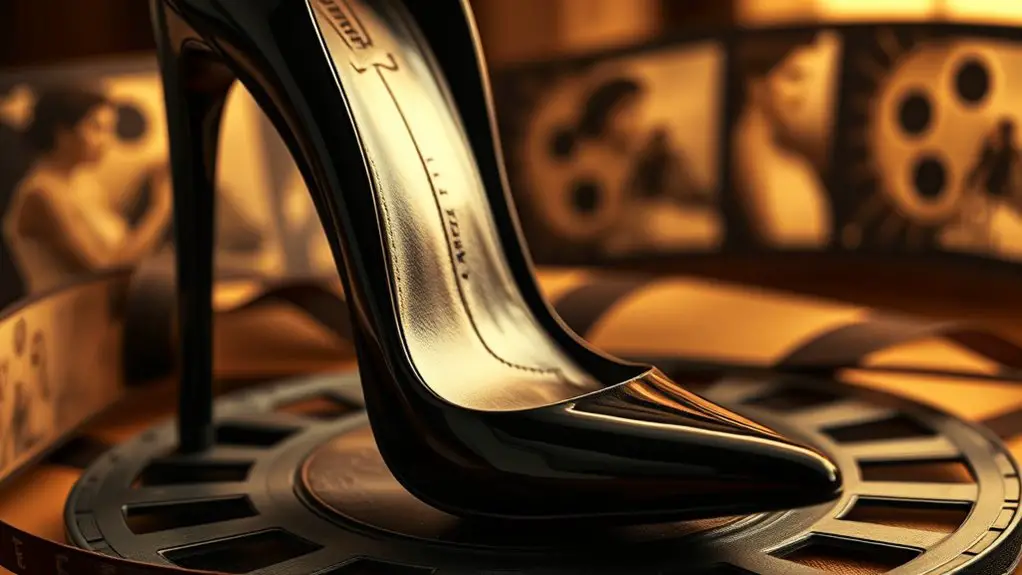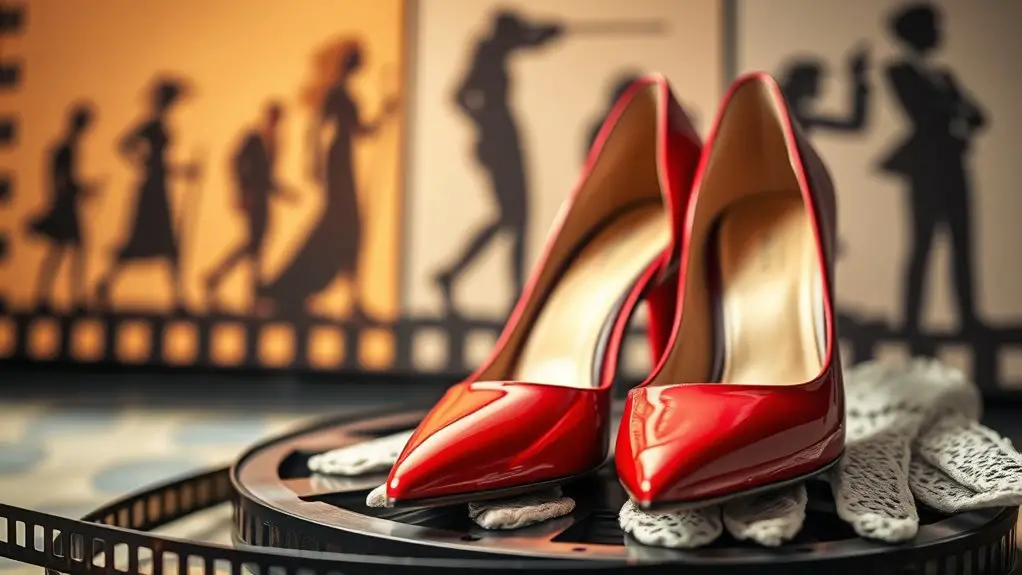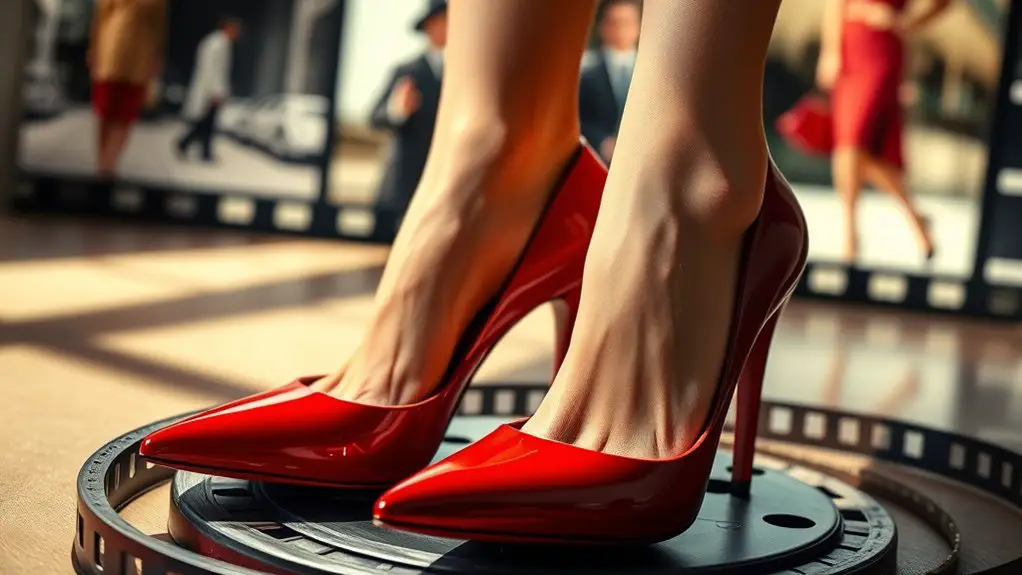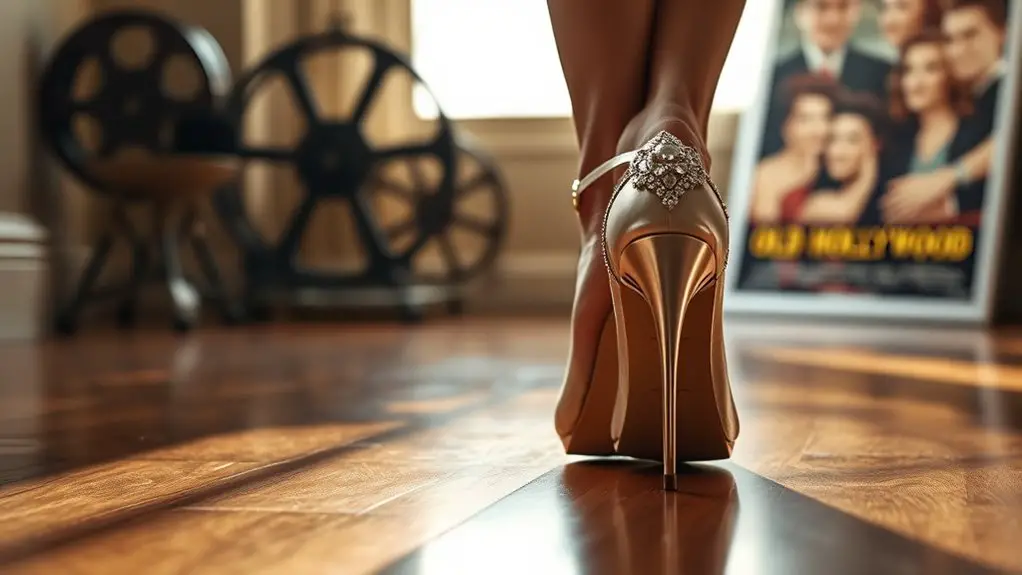In classic films, high heels symbolize femininity, power, and societal expectations. They serve as indicators of character status, enhancing gender dynamics and reflecting cultural values. Iconic moments, like Audrey Hepburn’s in “Breakfast at Tiffany’s,” demonstrate how high heels can signify personal transformation and empowerment. As characters navigate their journeys, their footwear choices reveal deeper insights into their motivations. Discover how these iconic styles shaped narratives and challenged norms in ways that still resonate today.
The Historical Context of High Heels in Film

Although high heels have long been associated with femininity and glamor, their presence in classic films reveals a deeper historical context that reflects societal norms and expectations. You’ll notice that high heels often symbolize power and status, illustrating how cinematic evolution mirrors changing attitudes toward women. In earlier films, heels accentuated a character’s allure, reinforcing traditional gender roles. As you explore further, think about how these shoes also served as a commentary on women’s liberation during pivotal historical moments.
Iconic High Heel Moments in Classic Cinema
When you think of classic cinema, certain high heel moments likely come to mind, each one leaving a lasting impression. These scenes not only showcase the art of elevated style but also carry deeper symbolism about femininity and power. As we explore these legendary moments, you’ll see how high heels transcend mere fashion to become potent symbols of character and narrative in film.
Legendary High Heel Scenes
High heels have long been more than just a fashion statement in classic films; they symbolize power, allure, and the complex dynamics of femininity. You can’t forget those legendary performances where memorable footwear took center stage, enhancing the narrative and character depth. Here are four iconic high heel scenes that resonate with audiences:
- Audrey Hepburn in “Breakfast at Tiffany’s” – Her chic stilettos embody sophistication and carefree elegance.
- Gilda in “Gilda” – Rita Hayworth’s entrance, complete with her dramatic heels, defines seduction.
- Marilyn Monroe in “The Seven Year Itch” – The subway grate scene immortalizes her playful femininity.
- Jessica Rabbit in “Who Framed Roger Rabbit” – Her towering heels symbolize allure and danger.
These moments showcase how high heels elevate character dynamics and cinematic storytelling.
Symbolism of Elevated Style
While many viewers might focus on the characters themselves, the high heels they wear often serve as powerful symbols of elevated style in classic cinema. These elevated aesthetics aren’t just about fashion; they convey confidence, power, and allure. Think of the iconic moments where a character’s entrance is punctuated by the sound of heels clicking—a subtle reminder of their presence and authority.
| Film | High Heel Moment |
|---|---|
| “Breakfast at Tiffany’s” | Holly Golightly’s entrance |
| “The Wizard of Oz” | Dorothy’s ruby slippers |
| “Gone with the Wind” | Scarlett O’Hara’s elegance |
These cinematic allure moments resonate, reminding you that high heels can transform a scene, imbuing it with depth and meaning.
High Heels as Symbols of Femininity

High heels have long been more than just a fashion statement in classic films; they embody the essence of femininity through iconic characters that redefine empowerment. As you explore these cinematic moments, consider how the evolution of high heels reflects changing cultural symbols and societal expectations. What do these towering shoes reveal about the women who wear them and the roles they inhabit?
Iconic Film Characters
Footwear often speaks volumes in film, and high heels have become powerful symbols of femininity that define iconic characters throughout cinematic history. These famous characters showcase high heels as more than just fashion statements; they embody confidence, seduction, and strength. Consider these heel icons:
- Dorothy Gale in *The Wizard of Oz* – Her ruby slippers symbolize hope and the journey of self-discovery.
- Carrie Bradshaw in *Sex and the City* – Her Manolo Blahniks represent urban sophistication and romantic ambition.
- Jessica Rabbit in *Who Framed Roger Rabbit* – Her towering heels emphasize allure and femininity.
- Marlene Dietrich in *Morocco* – Her bold choice of heels challenges gender norms and celebrates femininity.
These characters remind us that high heels often carry deeper meanings beyond their aesthetic appeal.
Fashion and Empowerment
When you step into a pair of high heels, you’re not just adding height; you’re embracing a long-standing symbol of femininity that intertwines fashion with empowerment. High heels represent a powerful statement, influencing how you carry yourself and how others perceive you. They can boost confidence, showcasing a blend of elegance and strength.
| Feminine Empowerment | Fashion Influence |
|---|---|
| Enhances posture | Defines trends |
| Symbolizes strength | Evokes emotion |
| Boosts confidence | Affects perception |
In classic films, this dynamic is evident as characters don high heels to assert their individuality and challenge norms. By wearing them, you participate in a tradition that celebrates both fashion and the empowering spirit of femininity.
Cultural Symbolism Evolution
As society’s views on femininity have evolved, so too has the cultural symbolism of high heels, which have shifted from mere fashion statements to powerful emblems of female identity. In cinematic history, high heels reflect broader cultural shifts and societal norms regarding gender representation. Their significance can be distilled into four key aspects:
- Fashion Trends: High heels have mirrored changing styles, revealing societal attitudes toward femininity.
- Character Symbolism: In films, they often signify empowerment or vulnerability, enhancing film aesthetics.
- Style Evolution: High heels adapt to reflect women’s roles, from homemakers to leaders.
- Cultural Commentary: They serve as a critique of traditional gender expectations, illustrating the dynamic interplay of fashion and identity.
The Power Dynamics of High Heels on Screen

There’s a certain allure to high heels that transcends mere fashion; they become symbols of power and authority in classic films. These shoes often serve as visual metaphors for power struggles, highlighting the dynamics between characters. When you see a woman in high heels, it’s not just about style; it’s a statement.
| Character Type | High Heel Significance |
|---|---|
| Femme Fatale | Exudes confidence, seduction |
| Authority Figure | Commands respect, dominance |
| Innocent Bystander | Highlights vulnerability |
In scenes where power dynamics unfold, high heels can elevate a character’s status, creating tension and intrigue. The way characters navigate their environment in these shoes often mirrors their control—or lack thereof—over their circumstances. Consequently, high heels not only enhance visual storytelling but also deepen the exploration of authority and influence on screen.
High Heels and Character Development
High heels play a significant role not just in establishing power dynamics but also in shaping a character’s journey throughout a film. You’ll often find that a character’s choice of footwear reflects their evolving character arcs and personality traits. Consider how high heels might:
High heels are pivotal in defining power dynamics and character evolution in film, reflecting personal growth and inner conflict.
- Signify Change: A character may start in flats, shifting to heels as they gain confidence or status.
- Enhance Conflict: Heels can create physical challenges that mirror internal struggles, emphasizing a character’s growth.
- Express Identity: The style and height of heels can reveal a character’s desires, ambitions, or insecurities.
- Contrast Motives: A character wearing heels in a moment of vulnerability highlights their complex nature and conflicting goals.
Through these elements, high heels become more than mere accessories; they’re integral to understanding a character’s development and the journey they undertake, adding depth to their story on screen.
Cultural Reflections Through High Heels
While many may view high heels merely as fashion statements, they often serve as powerful symbols of cultural values and societal norms in classic films. You can see how characters’ choices in footwear reflect the cultural significance of femininity, power, and sexuality. For instance, a character strutting in stilettos may embody the societal standards of ambition and allure, challenging traditional gender roles. Conversely, a character in flats might suggest rebellion against those very norms, offering a critique on the pressures women face.
High heels frequently signify status and sophistication, drawing lines between the elite and the everyday. They can also reveal underlying tensions in a character’s journey, showcasing the complexities of identity and self-expression. Through the lens of high heels, classic films provide a rich commentary on the evolving landscape of cultural expectations, inviting you to reflect on how fashion shapes and reflects our world.
The Evolution of High Heels in Modern Films
As society evolves, so do the representations of high heels in modern films, reflecting changes in gender dynamics and cultural attitudes. Today, high heels serve multiple purposes beyond mere fashion statements. They symbolize empowerment, confidence, and sometimes, subversion of traditional roles. Here are some modern trends and cinematic styles you might notice:
High heels in modern films reflect evolving gender dynamics, symbolizing empowerment and challenging traditional roles.
- Character Development: High heels often signify a character’s journey, enhancing their arc visually.
- Diverse Representation: Films increasingly feature women of all backgrounds, showcasing varied styles of high heels.
- Subversion of Norms: Some films challenge traditional associations, using heels to illustrate irony or critique societal expectations.
- Integration with Themes: Heels can reflect broader themes, like power vs. vulnerability, aligning with contemporary narratives.
In this evolving cinematic landscape, high heels continue to be a powerful tool for storytelling, reflecting both personal and societal transformations.
Memorable Performances That Redefined High Heels
Few cinematic performances have so profoundly altered the perception of high heels than those that blend fashion with character depth. Think of Audrey Hepburn in “Breakfast at Tiffany’s”; her iconic black dress and stilettos created an image of elegance while embodying Holly Golightly’s complex nature. The heels became a symbol of her aspirations and struggles, transforming them into unforgettable characters.
Similarly, Julia Roberts in “Pretty Woman” redefined the high heel’s narrative. Her character’s evolution from a streetwalker to a sophisticated woman happens through her choice of footwear, illustrating how high heels can signify empowerment. These elegant performances showcase how high heels aren’t just accessories; they reflect the inner lives of their wearers.
In both cases, you see how high heels transcend mere fashion, becoming integral to storytelling. Such roles remind us that every step taken in those heels carries deeper meanings, making them unforgettable in cinematic history.
Frequently Asked Questions
What Materials Were Commonly Used for High Heels in Classic Films?
You’d think high heels were all about style, but they’re often crafted from leather for durability and satin for elegance. This blend of materials elevates not just the shoe, but the entire cinematic experience.
How Did High Heel Styles Differ Across Various Film Genres?
High heel styles varied considerably across genres; in film noir, they exuded danger and allure, while romantic comedies showcased playful, whimsical designs, reflecting characters’ personalities. You can see how these choices enhanced storytelling and visual appeal.
Were There Any Notable High Heel Designers in Classic Cinema?
In the tapestry of cinematic history, notable high heel designers like Roger Vivier and Salvatore Ferragamo crafted iconic footwear through visionary collaborations, blending artistry and fashion, ultimately leaving an indelible mark on the silver screen’s glamorous legacy.
How Did Audiences Historically React to High Heels in Films?
Historically, audiences perceived high heels as symbols of glamour and status, reflecting cultural significance in femininity. As you analyze, consider how these perceptions shaped societal standards and influenced the portrayal of characters in film narratives.
Did Any Films Feature High Heels as a Plot Device?
You might be surprised to learn that high heels often symbolize power and femininity in films. They serve as a cinematic fashion device, subtly influencing characters’ narratives and their journeys, transforming mere footwear into potent plot elements.


